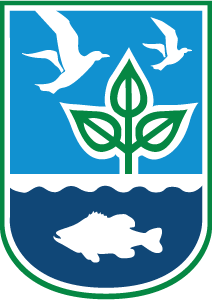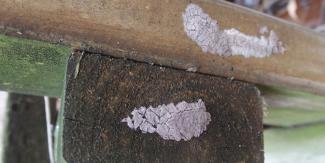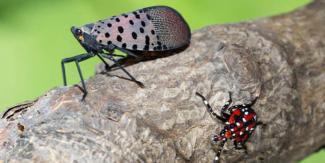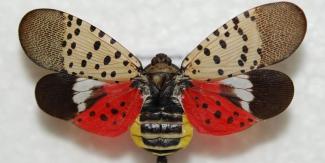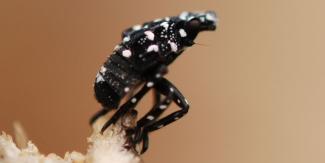Spotted Lanternfly
Overview
Spotted Lanternfly is an invasive plant hopper insect that was introduced into the United States in 2014. Native to China, this pest is associated with the invasive Tree of Heaven (Ailanthus altissima) but can also cause significant damage to grape, apple, stone fruits, walnut, and other economically important plants. It's also a significant nuisance that affects the quality of life and enjoyment of the outdoors. Rhode Island is at high risk of this invasive pest.
Although they can fly distances on their own, Spotted Lanternfly are excellent hitch hikers and mainly spread through human movement. Their inconspicuous egg masses can be laid on pallets, vehicles, and other goods. It’s important to check all your gear and equipment before traveling to and from Rhode Island, and scrape off any egg masses.
Description
Spotted Lanternfly (SLF) is plant hopper, a type of “true bug” that uses a stylet (or beak) to pierce plant tissue for feeding. In addition to the spotted patterning, the adult SLF’s unique colors feature scarlet underwings, yellow markings on its abdomen, and tan semi-transparent forewings. Adults about an inch in length and can be found late July into November. The nymph stage appears in June and July and feature strikingly bright red and black bodies with white spotting. Early stage nymphs lack the red color and appear completely black. Adult lanternflies are about an inch long and are active from August until the first hard freeze, which typically occurs from late October into November.
Spotted Lanternfly in Rhode Island
In 2021, a confirmed finding of a single Spotted Lanternfly (SLF) was found for the first time in Rhode Island in an industrial/commercial area in Warwick near Jefferson Blvd. In August 2022, DEM found an additional credible report of an invasive Spotted Lanternfly sighting in Smithfield. Patches of SLF found along Route 7 in Smithfield indicated Rhode Island's first confirmed population of SLF. This was later confirmed by US Department of Agriculture (USDA). DEM is currently surveying the area to determine the extent of its spread and working with USDA and the University of Rhode Island to minimize its spread. To date, SLF is established in Providence and Kent County.
If you suspect you found a spotted lanternfly
Early detection is key to protect Rhode Island's plants and forests. Help us prevent spotted lanternfly by learning how to identify the egg, nymph, and adult life stages of this pest.
SLF is established in Providence and Kent County. If you suspect you found a spotted lanternfly in Bristol County, Newport County, and South County take a photo and report it to DEM's Pest Alert Form. Note: Reports received will be reviewed by our staff for use in survey activities, but we may not respond to all submissions due to the large volume of reports received.
- For a comprehensive management control visit Spotted Lanternfly Management Guide
- SLF generally does not harm most trees and hardy plants. For local resources on , visit URI Biocontrol Lab

Downloadable Materials For Businesses
Although SLF can fly distances on its own, these pests are excellent hitch hikers and mainly spread through human movement. Their inconspicuous egg masses can be laid on pallets, vehicles and other goods, so it is important to inspect shipping materials and adhere to travel restrictions when moving through areas that are under quarantine for SLF. The following tips can help stop the spread of SLF:
- Inspect firewood, vehicles, outdoor furniture, and camping gear for egg masses, nymphs, and adults.
- Check all your gear and equipment before traveling to and from Rhode Island, and scrape off any egg masses.
SLF was first detected in Pennsylvania in 2014 and has quickly spread through surrounding states. In Pennsylvania, where the pest has been spreading for over six years, there has been significant yield loss in vineyards and the insect has become a public nuisance.
Here’s how businesses can help. Visit the USDA's website for free outreach materials to alert your team about the spotted lanternfly and how they can help stop it.
DEM Press Releases
- DEM Announces It Will Treat Targeted Sections of Lincoln that have Spotted Lanternfly Infestations with Insecticide (11/2/22)
- DEM Announces it will Spray Targeted Sections of Smithfield Along Douglas Pike that have Spotted Lanternfly Infestations with Insecticide Treatments (9/19/22)
- Spotted Lanternfly, an Invasive Pest Targeting Plants and Trees, Detected for the First Time this Year in Rhode Island (8/29/22)
Additional Resources
- URI Biocontrol Projects: Spotted Lanternfly
- Penn State Extension’s What to Look For page.
- SLF News: ARS Scientists Seek Answers from Spotted Lanternfly Dispersal
- SLF News: Spotted lanternflies have infested the region and researchers are hard at work trying to control their spread
- SLF News: Vineyards Facing An Insect Invasion May Turn To Aliens For Help
- SLF News: Plant Pro: Spotted Lanternfly
- SLF Lookalikes
- SLF Egg Scrape Card Template
- How to Remove SLF
Want to help?
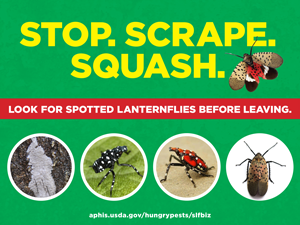
- Be Aware: Learn how to identify spotted lanternfly
- Check For Signs: Inspect your firewood, vehicles, outdoor furniture, and camping gear for egg masses, nymphs, and adults
- Inspect Items Being Moved: If you visit states with spotted lanternfly, check all your gear and equipment before leaving and scrape off any egg masses
